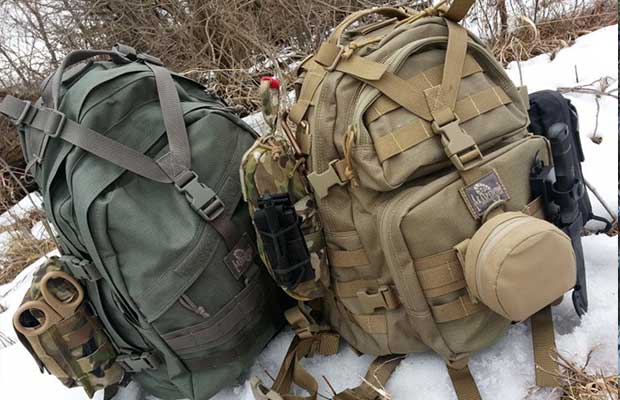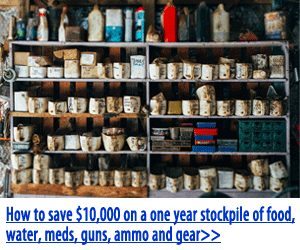How to Pack your Bug Out Bag
A Bug Out Bag is something that most of us are familiar with even if most of us do not have one loaded by the door or in the trunk of your car, ready to go at all times. For the uninitiated, the Bug Out Bag’s purpose is to give you everything you should need to live for 72 hours if you are forced to evacuate your location suddenly. A bug out bag should be pre-packed with all of your supplies so that you can grab it, throw it on your back and walk or run out your car, or head for the hills.
I have written a couple of other posts about Bug Out Bags and one dealt specifically on the subject of the contents of your bug out bag or BOB. My contention is that there are too many people that are throwing everything but the kitchen sink in their packs and I feel that there is something of an insane rush to get everything humanly possible into your BOB without much thought as to the why or the weight.
A bug out bag is not a U-Haul. It is not a Bug Out Suitcase even though I swear some people pack more into a Bug Out Bag than they do for a week down in Cancun. I have another post lined up to rehash this concept under a different theme, but I have heard others talk about packing 50 to 70 pounds in their Bug Out Bag and they plan to walk for hundreds of miles if necessary. 70 pounds???
I won’t get into weight or the absolute foolishness (in my opinion) of packing anything remotely that heavy in this post. I will talk about intelligently packing what you do have because regardless of whether you have an ultra-light pack or some behemoth weighing as much as a 4th grade boy, you need to pack this in a way that will make it as comfortable as possible to carry. We are going to talk about how to pack your bug out bag to take the most advantages of weight distribution and tried and true backpacking tips as possible. Backpackers have been bugging out for a long time and it pays to take a lesson or two from people who have more experience than the average Doomsday Prepper fan when it comes to packing everything they need for 72 hours on their back and living to talk about it.
Packing a backpack and packing a bug out bag are virtually identical. I would argue that you could just as easily bug out with a back pack as you could with any military looking pack from Blackhawk, maybe even easier. There are 4 simple rules to packing any pack you are going to carry on your back.
- Heaviest gear goes close to your back
- Light gear away from your back
- Frequently used items go on top
- Less used items go on bottom
The Basics of Pack Loading
Packing a backpack or packing your bug out bag are pretty similar. To be successful, you want to pack the right gear, but you need to pack it the right way too and that means keeping your center of gravity as close to you as possible. The last thing you need is a big pack that keeps you off balance and puts unneeded stress on your back.

Items like water and food usually weigh the most unless you have some really heavy gear in your bug out bag. A lot of people have moved to carrying water bladders like a Camelbak and most new packs have a place right inside the back next to your spine for carrying this. Keep the heavy stuff as close to you as possible and low as opposed to above your shoulders.
The Bottom of the Pack
Using the guidelines above, I pack the items I am going to need to get to least, at the bottom of the pack. My pack has a compartment in the bottom for my sleeping bag so that goes in first. Additionally, having your sleeping bag on the bottom gives you a nice soft cushion when you set your pack down. I have my sleeping bag in a compression sack, but if I have any fear of rain I would add a waterproof bag instead. Running out the door isn’t the time to worry about this, so it may make more sense for you to pack your sleeping bag in a waterproof sack regardless.
Next, I add my tent or hammock gear. I still prefer the tent and it is one of the last items I need so It goes in the bottom of the bag. Depending on the trip I also have a tarp that is attached at the bottom.
The Core of the Pack
Once I have my sleeping bag and tent in the bug out bag, I pack most of my spare clothes, then food and cooking gear. I say most of my clothes because depending on the weather I will carry a fleece or windbreaker too and I want this where I can get to it easily. My main food isn’t going to be eaten until I am at camp or stopped most likely.
I also carry a JetBoil that takes up about as much room as my food and I have my fuel in that same container. My jetboil can boil water for drinking, cook food or quickly heat my water for coffee in the mornings.
The Top of the pack
The top of your bug out bag or the pockets on the outside depending on what you are using should have the gear or equipment you are going to need the most. My pack has a compartment that is waterproof and that is where the lighters and fire kit go along with my headlamp and snacks. This way if I get hungry, I don’t have to dig in my bug out bag, just unzip the top compartment. On the backside of my pack, I have a zippered pocket for tp and spare cordage. I will also carry maps and maybe a camera.
What’s on the sides?
The sides usually hold the water filter, maybe some additional items depending on what I am carrying like spare water bladders. I carry two spares so that when I get to camp I can pump plenty of water for washing up, cooking and even breakfast in the morning. When they are empty they weigh nothing. My pack also has side pockets for my water bottles too and those work nicely because I can easily reach water while I am walking. One of these days I am going to pull the trigger and get a Camelbak so that I don’t have to carry it, but I still think the good old bottle is easier in some aspects.
That’s how I do it. How do you pack your bug out bag?
A Bug Out Bag is something that most of us are familiar with even if most of us do not have one loaded by the door or in the trunk





